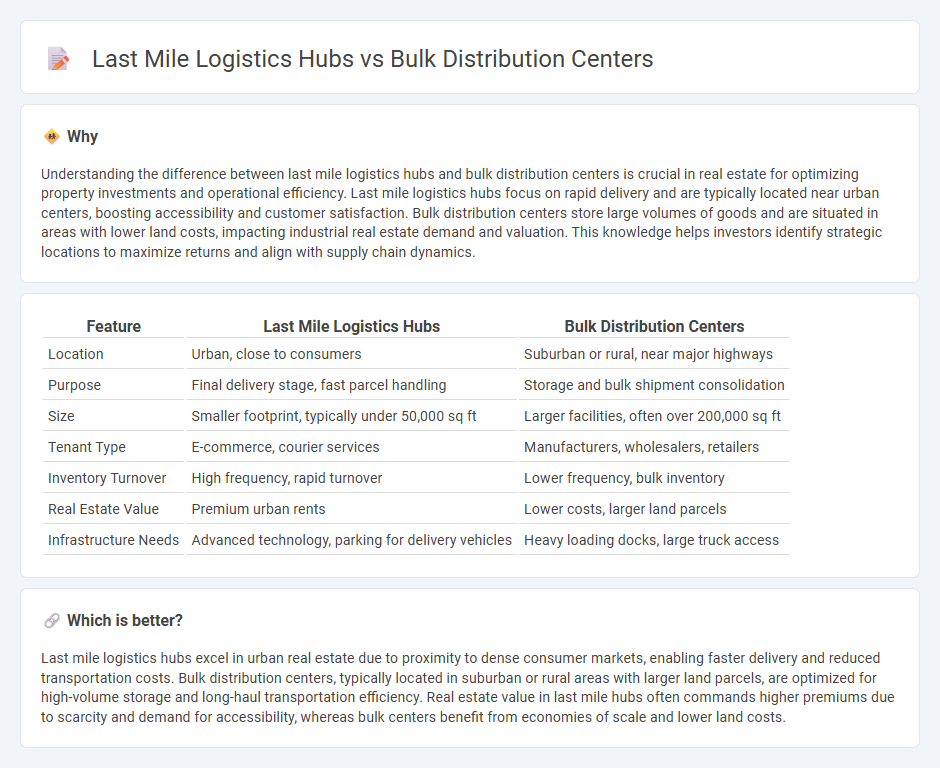
Last mile logistics hubs focus on rapid delivery and proximity to urban consumers, optimizing speed and efficiency for e-commerce fulfillment. Bulk distribution centers emphasize large-scale storage and centralized inventory management, targeting cost-effective transportation and supply chain consolidation. Explore how these real estate solutions impact supply chain strategies and urban development.
Why it is important
Understanding the difference between last mile logistics hubs and bulk distribution centers is crucial in real estate for optimizing property investments and operational efficiency. Last mile logistics hubs focus on rapid delivery and are typically located near urban centers, boosting accessibility and customer satisfaction. Bulk distribution centers store large volumes of goods and are situated in areas with lower land costs, impacting industrial real estate demand and valuation. This knowledge helps investors identify strategic locations to maximize returns and align with supply chain dynamics.
Comparison Table
| Feature | Last Mile Logistics Hubs | Bulk Distribution Centers |
|---|---|---|
| Location | Urban, close to consumers | Suburban or rural, near major highways |
| Purpose | Final delivery stage, fast parcel handling | Storage and bulk shipment consolidation |
| Size | Smaller footprint, typically under 50,000 sq ft | Larger facilities, often over 200,000 sq ft |
| Tenant Type | E-commerce, courier services | Manufacturers, wholesalers, retailers |
| Inventory Turnover | High frequency, rapid turnover | Lower frequency, bulk inventory |
| Real Estate Value | Premium urban rents | Lower costs, larger land parcels |
| Infrastructure Needs | Advanced technology, parking for delivery vehicles | Heavy loading docks, large truck access |
Which is better?
Last mile logistics hubs excel in urban real estate due to proximity to dense consumer markets, enabling faster delivery and reduced transportation costs. Bulk distribution centers, typically located in suburban or rural areas with larger land parcels, are optimized for high-volume storage and long-haul transportation efficiency. Real estate value in last mile hubs often commands higher premiums due to scarcity and demand for accessibility, whereas bulk centers benefit from economies of scale and lower land costs.
Connection
Last mile logistics hubs and bulk distribution centers form an integrated network critical for efficient real estate supply chain management, with bulk centers acting as primary storage facilities for large inventory volumes and last mile hubs facilitating rapid delivery to end customers. Strategic placement of these hubs near urban real estate hotspots enhances distribution speed, reduces transportation costs, and optimizes warehouse space utilization. The synergy between these facilities supports the growing demand for e-commerce fulfillment and urban delivery in commercial and industrial real estate sectors.
Key Terms
Warehouse Size
Bulk distribution centers typically span hundreds of thousands to over a million square feet, designed for large-scale storage and high-volume inventory management. In contrast, last mile logistics hubs are much smaller, often under 50,000 square feet, optimized for rapid sorting and delivery within urban areas. Explore the differences in warehouse size and functionality to determine the best fit for your supply chain needs.
Location Proximity
Bulk distribution centers are typically situated near major transportation routes or ports, optimizing the inbound flow of large shipments and minimizing long-haul transportation costs. Last mile logistics hubs are strategically located closer to urban centers or customer clusters to ensure faster delivery times and enhanced service quality. Explore more about how location proximity impacts supply chain efficiency and customer satisfaction.
Fulfillment Speed
Bulk distribution centers handle large volumes of inventory, optimizing storage efficiency and transportation costs but often require longer processing times due to order consolidation and sorting. Last mile logistics hubs prioritize rapid delivery by locating closer to end customers, significantly enhancing fulfillment speed and improving customer satisfaction in e-commerce. Explore the key differences in infrastructure and operational strategies to understand how each facility impacts overall delivery performance.
Source and External Links
What is a Bulk Storage Distribution Center? - A bulk storage distribution center is a facility designed to efficiently manage the storage and distribution of large quantities of goods, serving as a crucial link between manufacturers and end-users.
Distribution Centers Explained - Distribution centers are logistics facilities that store finished goods before they are picked and packed to fulfill customer orders, often serving retail companies, individual consumers, or both.
How Distribution Centers Work - Distribution centers manage inventory and logistics for retailers or fulfillment centers, focusing on moving goods in larger quantities than individual consumers need.
 dowidth.com
dowidth.com